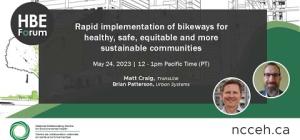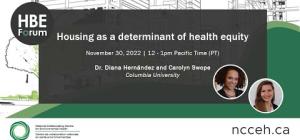
The four pillars of housing influencing health equity

Housing is a major pathway which generates and sustains health disparities – yet, our homes and neighbourhoods also have the opportunity to be a platform to promote health and flourishing. On November 30, 2022, the NCCEH hosted a webinar titled ‘Housing as a Determinant of Health Equity’ that was presented by Diana Hernández, PhD, and Carolyn Swope, MPH. The hour-long webinar that included an engaging question-and-answer period offered a holistic conceptual model of the impact of housing on health disparities. Understanding how housing impacts health requires taking into account the range of harmful exposures, their cumulative burden, and the historical processes and policies shaping unequal housing opportunities. In this blog, the presenters summarize the evidence about housing and health, and paths forward to leverage housing as a platform to promote health equity.
Four pillars of housing and health
A conceptual model of housing and health disparities

The relationship between housing and our health has become acutely evident during the Covid-19 pandemic. Evidence has continued to emerge to support the role of housing in infectious disease transmission – from the conditions of our indoor environments, to our ability to maintain safe and affordable housing, to neighbourhood risk factors such as transportation and types of employment opportunities. Indeed, the physical and social environments of our homes and neighbourhoods can support – or harm – our health in many ways, across all kinds of different health and wellbeing outcomes. Specifically, health-promoting housing factors span four key pillars:
- Housing conditions and quality: The physical conditions of the housing unit or apartment building can include many dangerous defects and safety hazards. Some examples include lack of thermal comfort, pests, dampness and mold, hazardous building and furniture materials (e.g., lead or asbestos), unsafe drinking water, secondhand smoke, and risk factors for injury (e.g., lack of window guards or lack of functioning smoke alarms). Together, these problems can cause health issues ranging from allergies and asthma to poorer mental health.
- Housing affordability: Housing costs can include not just rent or mortgage payments but also costs such as property taxes, water, and utility services. Living in unaffordable housing is directly linked to poorer outcomes such as worse self-rated health, hypertension, arthritis, and unsurprisingly, mental health. Unaffordability can also impact health indirectly by draining financial resources that could otherwise be used for health-related needs, such as food, dental care, or prescriptions.
- Residential stability: Residential stability encompasses residents’ capacity to willingly remain in their homes free from harassment or dispossession. Going beyond a dichotomy of housed or unhoused, residential stability takes into account a spectrum of temporary or insecure housing arrangements, including forced displacement from homes and communities (e.g., eviction), overcrowding or “doubling-up,” and frequent moves. In addition to contributing to poorer mental health, displacement can disrupt access to health-relevant resources like employment, health care, and social support.
- Neighbourhood conditions: The context of where housing is situated also impacts residents’ health. That can include everything from features of the built environment such as walkability; to availability of health-related resources such as healthy food options; to environmental burdens such as polluting facilities; to social characteristics such as the availability of support networks. Some neighbourhoods may offer a healthier environment – e.g., be more walkable, have plenty of vegetation and shade to protect from extreme heat, and offer plenty of fresh food options. But others may have a disproportionate share of hazardous characteristics and lack health-promoting resources. For example, they may host sources of pollution like highways and factories; have high concentrations of tobacco, liquor and fast food outlets; and experience high rates of violence.
The impacts of these four pillars don’t exist in isolation; they are often experienced in tandem, or interact with other aspects of residents’ lives that affect their health. Marginalized groups may be particularly likely to experience heightened susceptibility to one or more of the above pillars. The same exposure doesn’t necessarily equate to the same effect for every person. Factors such as life stage or exposure to stress and discrimination could all contribute to increased vulnerability and amplify housing exposures’ effect. Furthermore, the likelihood of exposure to unhealthy housing is not randomly distributed, so the same people may be likely to experience unhealthy housing across multiple pillars. Additionally, people with limited resources may make trade-offs, achieving health in one pillar while sacrificing it in another. As a result, the health burden of housing-related exposures can be amplified by the compounding impacts of these different pillars, and with other structurally-rooted inequalities. It is therefore critical to think about housing pillars holistically and with awareness of their social context. For example, making changes in one housing pillar could cause disruption to another (e.g., greater neighbourhood affordability may bring trade-offs with the amenities and hazards of a neighbourhood).
The historical and ongoing production of housing inequities
The housing and neighbourhood characteristics which can promote or harm our health are distributed inequitably – and this inequitable distribution did not happen ‘naturally’. Rather, it is in large part due to the historical and ongoing creation and reinforcement of racialized and exclusionary practices, which denied marginalized groups full control over their residential choices and created segregated landscapes of uneven resources and opportunity.
Historical processes created property systems stratified by dimensions of inequality such as race and class, which devalued poor and nonwhite places, and often subjected such places to clearance and redevelopment, displacing their residents. A critical example of this in Canada is the settler-colonial dispossession of Indigenous peoples from their lands and creation of an inequitable reserve system. Racial discrimination in housing has also been a long-term issue, manifesting in ways such as landlords refusing to rent to racial minorities and immigrants.
In the present day, housing disparities continue to be reinforced through processes including gentrification, evictions, housing discrimination, and shifts in government housing assistance policy (e.g., reduced investment in, or demolition of social housing). For example, eviction not only directly contributes to poor health – such as depression, adverse birth outcomes, and disruption of health care access – but also perpetuates disparities in access to healthy housing moving forward, as landlords often refuse to rent to tenants with eviction records. In Canada, Indigenous Peoples (13%) and Black people (12%) are almost twice as likely to report having experienced an eviction as people who are not a visible minority (7%). Non-white immigrant and refugee newcomers also face challenges in securing and maintaining housing, with main barriers reported as animosity based on country of origin, immigration status, ethnicity or race, as well as affordability problems. Research suggests that Indigenous Peoples have also historically faced, and continue to face, housing-related discrimination – which has been found to manifest in poorer neuroendocrine, cardiovascular, metabolic and immune system functioning.
How do these policies and processes eventually come to impact health? For one, spatially concentrating marginalized populations makes it easier to deny beneficial investment and resources to their communities, while pushing harmful (e.g., polluting) land uses there. Furthermore, by artificially constraining housing supply for racialized households, segregation can make it easier to charge them more for poorer-quality housing. Finally, preventing equal opportunity for home ownership contributes to a wealth gap – which continues to limit the ability to afford healthy housing in healthy neighbourhoods, and can also affect health through other channels related to socioeconomic status.
A vision for housing as a platform for health equity
“Health equity in housing would entail opportunities for all individuals, regardless of race/ethnicity, socioeconomic status, household composition, or zip code, to benefit from developments in modern building science, fair maintenance practices, community planning, and creative uses of space through programming, to foster a culture of health and social connections.” (Diana Hernández and Carolyn Swope, American Journal of Public Health, 2019)
We conclude by offering a comprehensive vision for healthy housing that examines the impact of housing on health through a historical and social justice lens, which can help to better design policies and interventions that use housing to promote health equity.
Every home would offer conditions supportive of health and well-being as standard practice rather than luxury amenities, and be affordable to all income levels. Every home would offer its residents safe air quality, with adequate ventilation and smoke-free policies, and without toxic materials and products, mold, and pest infestations. Every home would be free from injury hazards. And every home would be energy-efficient, helping to ensure residents can afford heating, cooling, and water without sacrificing other health-related needs. Furthermore, in multi-unit buildings, there would be amenities such as green space, community gathering spaces, and active design elements.
Furthermore, every neighbourhood would offer residents equal opportunity to access health-promoting resources – from parks and playgrounds, to public transportation, to protection from extreme heat and flooding. And no neighbourhood would bear a disproportionate burden of health hazards from toxic facilities and infrastructure. This more equitable distribution would occur without placing residents at risk of physical or cultural displacement.
Environmental public health professionals are well-positioned to play an important role in making the above vision a reality. They can do so by various means such as educating the public about the above four pillars of housing and health, and promoting effective implementation of provincial public health legislation. Through these actions, EPHPs can help to promote and protect healthy, equitable housing for all.
Authors
Carolyn Swope is a PhD candidate in Urban Planning at Columbia University, and also holds an MPH in Sociomedical Sciences from Columbia University. Broadly, her research interests focus on the relationship between housing and health disparities, with particular attention to historical housing policies producing present-day housing inequities. Currently Carolyn is working on her dissertation, which examines how gentrification is connected to other forms of racialized dispossession, and how this informs its effects on health for Black residents.
Diana Hernandez, PhD is a tenured Associate Professor of Sociomedical Sciences at Columbia University's Mailman School of Public Health. Dr. Hernandez conducts research at the intersection of energy, equity, housing and health. A sociologist by training, her work focuses on the social and environmental determinants of health and examines the impacts of policy and place-based interventions on the health and well-being of socioeconomically disadvantaged populations.
Liv Yoon, PhD is an Assistant Professor in the School of Kinesiology at the University of British Columbia in Vancouver, Canada, interested in the nexus of climate change, social inequities and health. Her ongoing work includes exploring the indoor environment quality in subsidized housing and its impacts on the health of marginalized populations.
Declaration: Carolyn Swope receives fees as a consultant for Delos Living, unrelated to her work on this blog post.








